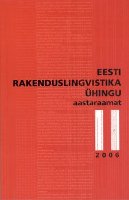Reeglid ja analoogia võõrkeeleõppes soome mitmusevormide käänamise näitel
Rules and analogy in foreign language learning: Finnish plural forms as an example
Author(s): Annekatrin KaivapaluSubject(s): Language and Literature Studies
Published by: Eesti Rakenduslingvistika Ühing (ERÜ)
Keywords: non-native language acquisition; Estonian and Russian learners; language testing; morphological skills; inflectional strategies; crosslinguistic influence; Finnish
Summary/Abstract: This article deals with the processing strategies of Estonian and Russian learners inflecting some plural forms of Finnish nouns. The analysis is based on written and oral tests of context-free words and on the use of the same words in written narratives. The second data-type consists of the comments of the learners on their processing, and interviews with the learners. Both data types were used to determine the functions and efficiency of two central processing strategies, rules and analogy. The aim of the study was to explore whether, how and to what extent the source language and the level of target language skills influence the choice of processing strategy. The study concludes that both the Estonian and the Russian learners produce the plural forms of the test words by applying rules, by combining stem allomorphs and inflectional allomorphs, and by analogy with the familiar target language words. The use of rules is more efficient in a situation when there are no exceptions and the inflectional process is algorithmically easy to describe. Where the inflectional process is complex, non-linear and hierarchical, analogy with the target language leads to better results. However, the distribution and functions of the main inflectional strategies used by Estonian and Russian learners are different. Due to the similarity of the morphological systems of two closely related languages, Estonian and Finnish, the Estonian learners produce plural forms of Finnish both by analogy with the target language and by analogy with the source language. It is important to emphasize that while the analogy with the source language is based mainly on the similarity of word forms, the analogy with the target language tends to be based on the similarity of paradigms. The beginner level Finnish learners of Estonian origin also blend the codes of the source and the target languages by combining stem and inflectional allomorphs of both languages within the same word. Thus the inflectional systems of the two closely related languages are not yet separated in the minds of the beginners of the Estonian origin to the same extent as they are in the minds of the advanced Finnish learners of the Estonian origin. The learners of teh Russian origin begin their inflectional process at first by applying the rules and they use analogy only if the processing by rules does not succeed. An interesting transitional variant between the rules and the analogy is the so-called paradigmatic analogy: learners place words analogically into morphological type (paradigm) according to the final sounds of the word and then inflect them by the rules for the type. Consequently, it appears that the choice of the processing strategy depends, at least partly, on the source language and the level of the target language skills of the learners.
Journal: Eesti Rakenduslingvistika Ühingu aastaraamat
- Issue Year: 2006
- Issue No: 2
- Page Range: 071-092
- Page Count: 21
- Language: Estonian

